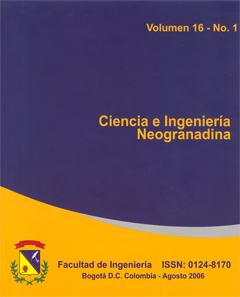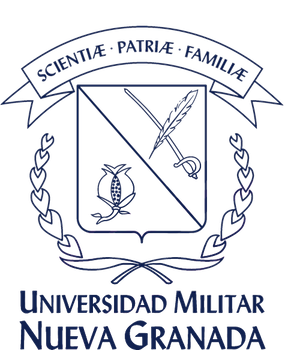Control de manipuladores teleoperados
Resumen
Este trabajo presenta una revisión bibliográfica acerca de distintos modelos utilizados en el diseño de controladores para manipuladores teleoperados, se realiza una descripción tanto de las ventajas como de los problemas que se presentan al momento de implementar sistemas de control con técnicas convencionales e inteligentes (Redes Neuronales y Lógica Difusa) en estos dispositivos. También se abordan descriptivamente los sistemas teleoperados, para finalmente presentar una sección especializada en la que se muestran estrategias de control empleadas para tratar los retardos de señal inherentes a la teleoperación de manipuladores. En la última sección se citan algunas aplicaciones importantes para estos sistemas.Descargas
Lenguajes:
esReferencias bibliográficas
J. J. Craig, Introduction to Robotics: Mechanics and Control, P. Hall, Ed., 2003.
A. Barrientos, L. F. Peñín, C. Balaguer, and R. Aracil, Fundamentos de Robótica. McGrawHill, 1998.
Y.-C. Hsu, G. Chen, and H.-X. Li, “A fuzzy adaptive variable structure controller with application to robot manipulators,” IEEE Transactions on systems, man and cybernetics, vol. 31, no. 3, June 2001.
J. S. Albus, “A new approach to manipulator control: The cerebellar model articulation controller,” J. of Dynamic Sys., Measurement and Control, ASME, pp. 220–227, 1975.
J.-H. rya, D.-S. Kwon, and B. Hannaford, “Control of a flexible manipulator with noncollocatet feedback: time-domain passivity approach,” IEEE Transactions ont Robotics, vol. 20, no. 4, pp. 776 – 780, August 2004.
D. Moschini and P. Fiorini, “Performance of robotic teleoperation system with flexible slave device.” ” Proceedings of International Conference on Robotics and Automation (ICRA) (2004), 2004.
A. Albu-Schaffer, F. Christian Ott, and G. Hirzinger, “Cartesian impedance control of redundant robots: Recent results with the dlr-lightweight-arms,” ICRA, pp. 3704– 3709, 2003.
K.-S. Chang and O. Khatib, “Manipulator control at kinematic singularities: A dynamically consistent stategy,” Proc. IEEE/RSJ Int. Conference on Intelligent Robots and Systems, vol. 3, pp. 84–88, 1995.
A. A. M. Rodney G. Roberts, “Nearest optimal repeatable control strategies for kinematically redundant manipulators,” IEEE Transactions on robotics and automation, vol. 8, no. 3, pp. 327–337, June 1992.
S. Tong, H.-X. Li, and G. Chen, “Adaptive fuzzy decentralized control fo a class of largescale nonlinear systems,” IEEE Transactions on systems, man and cybertnetics, vol. 34, pp. 770– 775, 2004.
S. Tong, H.X.Li, and G. Chen, “Adaptive fuzzy decentralized control for a class of largescale nonlinear systems,” IEEE Trans. on Sys. Man Cybern., vol. PP, p. 1096, 2003.
J. W.Chang, Y.H.Joo, and GC, “Output feedback fuzzy control for uncertain nonlinear systems,” ASME Journal of Dynamic Systems, Measurement and Control, vol. 125, pp. 521– 530, 2003.
C. Ham, Z. Qu, and R. Johnson, “Nonlinear robust fuzzy control for robot manipulators,” IEE: Control Theory and Applications, vol. 147, 2000.
G. R.Ranganathan, H.A.Malki, “Fuzzy predictive pi control for processes with large time delay,” Expert Systems, vol. 19, pp. 21– 23, 2002.
J.Carvajal, GC, and H.Ogmen, “Fuzzy pid controller: Design, performance evaluation, and stability analysis,” J. of Inform. Sci., vol. 123, pp. 249–270, 2000.
J.Lu, GC, and H.Ying, “Predictive fuzzy pid control: Theory, design, and simulation,” Information Science, vol. 137, pp. 157–187, 2001.
W.M.Tang, GC, and R.D.Lu, “A modified fuzzy pi controller for a flexible-joint robot arm with uncertainties,” J. of Fuzzy Sets and Systems, vol. 118, pp. 109–119, 2001.
H.X.Li and GC, “Dual features of conventional fuzzy logic control,” Acta Automatica Sinica, vol. 27, pp. 1–13, 2001.
D.Misir, H.Malki, and GC, “Design and analysis of a fuzzy proportional-integralderivative controller,” J. of Fuzzy Sets and Systems, vol. 79, pp. 297–314, 1996.
H.Malki, D.Misir, D.Feigenspan, and GC, “Fuzzy pid control of a flexible-joint robot arm with uncertainties from time-varying loads”, IEEE Trans. on Contr. Sys. Tech., vol. 5, pp. 371–378, 1997.
M. T. Eskil, M. O. Efe, and O. Kaynak, “Tnorm adaptation in fuzzy logic systems using genetic algorithms,” ” 1999.
K.S.Tang, K.F.Man, GC, and S.Kwong, “An optimal fuzzy pid controller,” IEEE Trans. on Indus. Elect., vol. 48, pp. 757–465, 2001.
Y. Zhang, J. Wang, and Y. Xia, “A dual neural network for redundancy resolutin of kinematically redundant manipulators subject to joint limits and joint velocity limits,” IEEE transactions on neural netwoks, vol. 14, no. 3, pp. 658–667, 2003.
S. Hu, M. H. A. Jr., and H. Krishnan, “Online neural network compensator for constrained robot manipulators.” ” Asian Control Conference? 2000, 4-7 July 2000, Shanghai, China., 2000.
C.Wang, GC, and S.S.Ge, “Smart neural control of uncertain nonlinear systems,”Int. J. of Adaptive Control and Signal Processing, vol. 17, pp. 467–488, 2003.
Q. Gan and E. Rosales, “Cmac with linear functional weights,” in In Proc of the 13th IFAC Symposium on Systems and Identification (SYSID’2003), pages 1838-1843, The Netherlands,
August 2003., 2003.
P. E. Almeida and M. G. Simoes, “Parametric cmac networks: Fundamentals and applications of a fast convergence neural structure,” IEEE Transactions on industry applications, vol. 39, no. 5, pp. 1551–1557, 2003.
S. Sayil, “A combine algorithm for a cmac network,” PAU Journal of Engineering Science, 2001.
C. M. Clark and J. K. Mills, “Robotic system sensitivity to neural network learning rate: Theory, simulation and experiments”, The International Journal of Robotics Research, vol. 19, no. 10, pp. 955–968, 2000.
X.F.Liao, GC, and E.N.Sanchez, “Lmibased approach for asymptotically stability analysis of delayed neural networks,” IEEE Trans. on Circ. Sys.-I, vol. 19, pp. 1033– 1039, 2002.
A. Bogdanov and A. Timofeev, “Robust optimal neural control of robots,” Proceedings of IEEE international conference IJCNN99, IEEE, Washington, D.C., Jul, 1999, pdf., December 1999.
P. van der Smagt, “Cerebellar control of robot arms,” Connections Science, vol. 10, no. 10, pp. 301–320, Dicember 1998.
M. T. Rosenstein, “Learning to expoit dynamics for robot motor coordination”, Ph.D. dissertation, University of Massachusetts, 2003.
J. M. A. Poveda, “Control bilarteral por convergencia de estados de sistemas teleoperados con retardos en las transmisión,” Ph.D. dissertation, Universidad Miguel Hernández, 2003.
J. Vertut and P. Coiffet, Teleoperation and Robotics. Evolution and Development. Kogan Page, 1985.
W. R. Ferrell, “Delayed force feedback,” IEEE Transactions on Human FActors in Electronics, vol. 8, pp. 449–455, 1966.
P. Batsomboon, S. Tosunoglu, and D. W. Repperger, “A survey of telesensation and teleoperation technology with virtual reality and force reflection capabilities,” International Journal of Modeling and Simulation, vol. 20, pp. 79–88, 2000. [Online]. Available:
J. Yan and S. Salcudean, “Teleoperation controller design using h-optimization with application to motion -scaling,” IEEE Transaction on Control Systems technology, vol. 20, 1996.
G. Feng and G. Chen, “Adaptive control of discrete-time chaotic systems: a fuzzy control approach,” Chaos Solitns & Fractals, vol. 23, pp. 459–467, 2005.
R. Aracil, J. Bario, M. Ferre, and J. M. Bogado, “Identificación y modelado de un sistema maestro-esclavo para teleoperación,” in XXV Jornadas de Automática, 2004.
R. A. C. Bianchi, B. S. M. Jr, F. C. Ferrez, and A. H. R. C. Rillo, “Operation of a robotic manipulator through the www,” FEI, 1998.
M. R. Stein, “Behavior -based control for time-delayed teleoperation,” Ph.D. dissertation, University of Pennsylvania, 1994.
G.Ñiemeyer, “Using wave variables in time delayed froce reflecting teleoperation,” Ph.D. dissertation, Massachusetts Institute of Technology, 1996.
S. Salcudean, W. Zhu, P. Abolmaesumi, S. Bachmann, and P. Lawrence, “A robot system for medical ultrasound,” 1999.
R. P. Goldberg, M. Dumitru, R. H. Tailor, and D. Stoinanovici, “A modular robotic system for ultraound image acquisition,” Proceeding of the 4th INternational Conference on Medical Image Computing and Computer-Assisted Intervention, vol. 2208, pp. 1430–1432, 2001.
J. Stoll, P. Dupont, and R. Howe, “Ultrasound-based servoing of manipulators for telesurgery,” Telemanipulator and Telepresence Technologies VIII Conference. Proceeding of the SPIE, vol. 4570, 2001.
F. T. S. S. S. M. Cenk Cavosoglu, Wintrhop Williams, “Robotics for telesurgery: Second generation berkeley / ucsf laparoscopic telesurgical worksatation and looking rowards the future applications,” in In Proceeding of the 39th Allerton Conference on Communication, Control and Computing, 2001.
X. Yang, Q. Chen, D. C. Petriu, and E. M. Petriu, “Internet-based teleoperation of a robot manipulator for education,” Haptic, Audio and Visual Environments and Their Applications, 2004. HAVE 2004. Proceedings. The 3rd IEEE International Workshop on, pp. 7 – 11, 2004.












